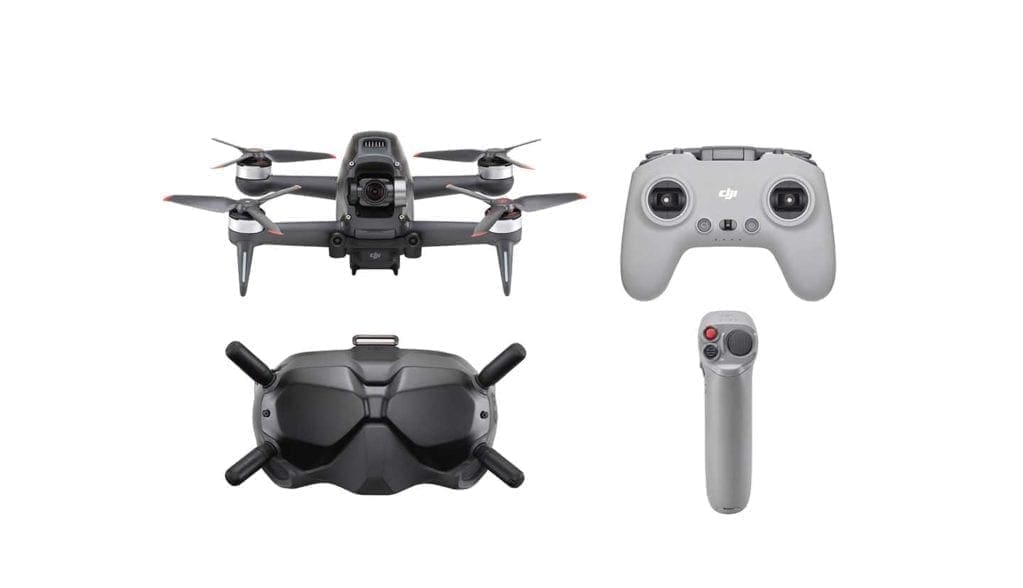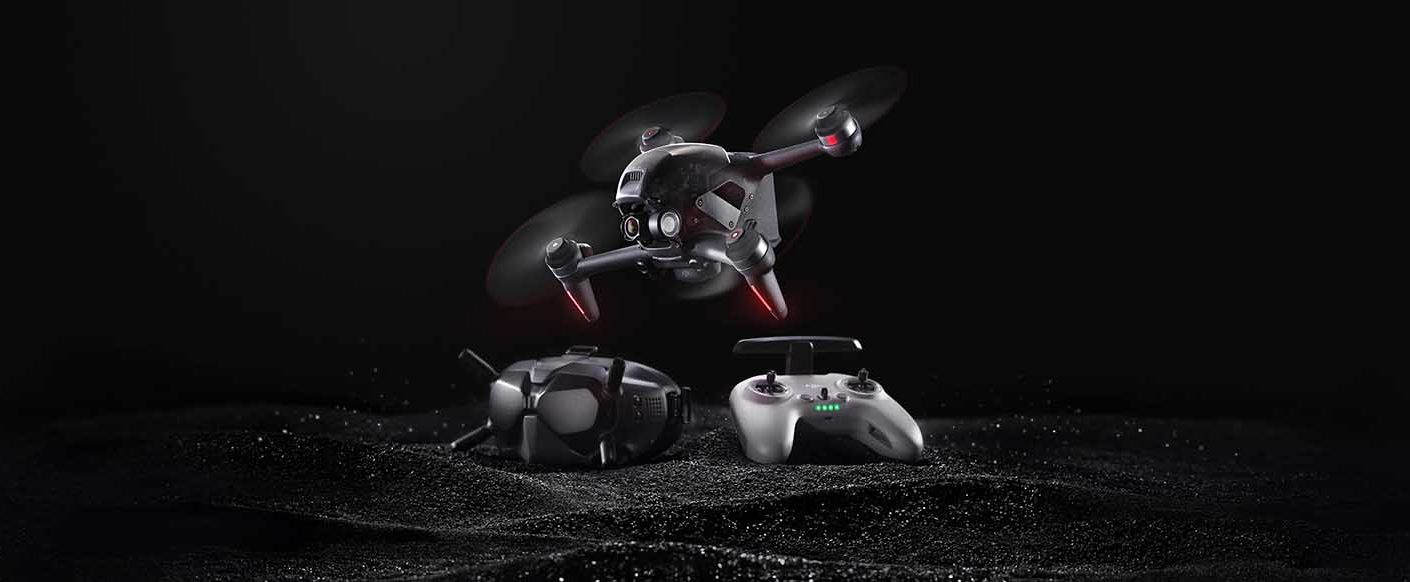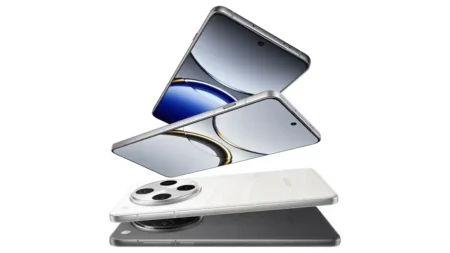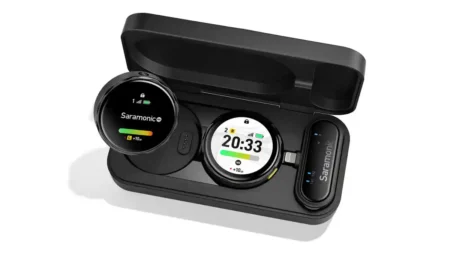DJI has announced the DJI FPV, price tag from £1,249 / €1,349, a radical new design on its drone technology that offers a first-version view and high-speed performance.
Our full review of the DJI FPV can be seen here along with sample footage
The DJI FPV opens a new range of drones for the company. The immediate standout features of the DJI FPV is that it incorporates DJI’s goggles and a dedicated remote controller, along with motion control, that allow you to see a long-range, low-latency view from the drone itself as it flies. The aim is to provide a much more immersive experience in drone piloting.
The DJI FPV is also the first integrated FPV drone that allows pilots of all abilities the choice a flight mode that matches their skill level. Modes include:
Normal (N) Mode: During N mode operation, DJI FPV operates similar to other DJI drones, hovering in place with the use of GPS and/or visual positioning systems (VPS) on the bottom of the drone. The most approachable flight mode, N mode allows for obstacle detection sensors on the front to be activated to warn when obstacles are near and slow down. Pilots are tasked with maneuvering the drone away from any detected obstacles.
Manual (M) Mode: Take full control over the drone with M mode which is designed for more experienced users. While in M mode, all sensors and hovering features are disabled.
Sport (S) Mode: A new hybrid blend of M and N mode, the S mode offers some of the dynamic movement capabilities that come with M mode along with some of the key safety features of N mode. S mode is the middle step between the three modes and developed to give pilots more room to explore their skills as they get accustomed to the drone.
The DJI FPV can fly at speeds up to 87mph / 140kph, with acceleration to 62mph / 100kph in just 2secs. It also offers a 10km transmission range, auto-switching dual-frequencies, a high bitrate of 50Mpbs and anti-interference technology to provide a reliable feed. Viewing options include:
Standard low-latency HD mode: See the world in 1440x810p in either 60 fps with a wider 142° Field of View (FOV), or 50 fps with 150° FOV. In this mode, latency is as low as ≤ 40 ms.
Smooth mode: In this mode, pilots activate high frame rates for a more cinematic look but signal latency is decreased to ≤ 28 ms. Resolution is 1440×810p 120 fps with 142° FOV or 100 fps at 150° FOV.
Audience mode: Share the pilot’s perspective in audience mode, which connects up to eight additional Goggle sets to the pilot’s view so even onlookers can experience the flight.
Follow the link to read our DJI FPV review.
DJI FPV Video
The DJI FPV can provide 4K video footage at up to 60fps. What’s more, DJI has incorporated its RockSteady electronic image stabilisation into the drone to ensure stable, cinematic quality.
You can also record video in 1080p at 120fps for 4x slow motion videos. Footage can also be stored in H.265 or H.264 compression standards.
The integrated camera is also mounted on a single-axis gimbal, providing stability during intricate manoeuvres while rotating vertically.
DJI FPV Additional safety features
When DJI introduced drone automatic breaking to their Phantom range, it was a major innovation and probably one of the drones’ biggest safety updates.
Due to the unprecedented speeds achieved with the FPV, new emergency brake and hover features have been added.
GPS-based geofencing has been enhanced, advising pilots of airspace restrictions and potential hazards; this will also automatically prevent drones from flying near certain high-risk locations, such as airports.
A relatively new addition to the DJI drones is the AirSense ADS-B receiver which automatically alerts pilots if planes or helicopters are close by.
Safety of drone use is a huge priority for DJI, and the enhanced emergency brake and hover, ADS-B, VPS, failsafe return and geofencing are all designed to ensure that the DJI FPV is as safe to fly as possible.
DJI FPV enhanced flying experience
The DJI FPV features the most advanced image transition technology from the company so far. HD footage is fed through a low-latency feed from the DJI FPV to the DJI FPV goggles V2.
The new motors are racing spec, and while the DJI FPV is aimed at those wanting to film sports and events rather than FPV racing, the speed and power is impressive.
At 140kph (87mph) and max acceleration of 0-100 kph (0-62 mph in just 2 seconds), the company has released one of the fastest drones outside of the FPV racing market.
These speeds will enable the drone to keep up with the fast-paced action or on and off-road racing with ease.
The latest image transmission system enables a distance of up to 10km, although UK restrictions mean that this isn’t a feature that should be used. That transmission is sent at 50Mbps, so the image you see will be clear and crisp.
The pilot can adjust the quality of the transmitted image with the following options:
Standard low-latency HD mode: See the world in 1440x810p in either 60 fps with a wider 142° Field of View (FOV) or 50 fps with 150° FOV. In this mode, latency is as low as ≤ 40 ms.
Smooth mode: In this mode, pilots activate high frame rates for a more cinematic look, but signal latency is decreased to ≤ 28 ms. Resolution is 1440×810p 120 fps with 142° FOV or 100 fps at 150° FOV.
Incredible Flight Performance, Breathtaking Footage
Audience mode: Share the pilot’s perspective in audience mode, which connects up to eight additional Goggle sets to the pilot’s view so even onlookers can experience the flight.
Now for the part that we as imaging enthusiast want to hear, camera and image quality.
Usually, the small FPV drones feature low-resolution cameras designed to keep up with the action while providing a smooth continuous live feed.
The integrated 4K 60fps camera captures footage at 120 Mbps and is mounted on a single axis gimbal. This might not offer the outstanding mechanical stabilisation that we’re used to with the Inspire and Phantom ranges, but with RockSteady digital stabilisation, the footage should be nice and smooth.
The rocksteady stabilisation will also eliminate the rolling shutter effect when filming fast action scenes. As we’ve seen in past DJI cameras, there’s advanced distortion correction to remove warping and the fisheye look from the footage.
As ever, there will be a good selection of filming options with 4X slow motion filmed at 1080p 120fps.
Footage can be filmed in either H.264 or H.264, making the most from the small SD card storage.

DJI FPV Price & Release Date
The DJI FPV drone price tag will be £1,249 / €1,349 for the drone, remote controller 2, FPV Goggles V2, cables and one battery.
The DJI FPV Fly More Kit is priced £259 / €279 and includes two additional batteries and the dedicated charging hub. You can also buy a separate Motion Controller for £139 / €149.
Follow the link to read our DJI FPV review.



